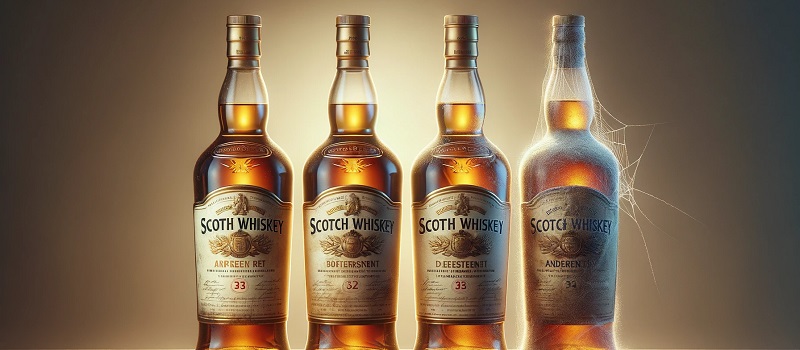🔥 Popular Free Downloads

THE FULL WORKS
All of our staff training manuals in one handy download!

FREE STAFF HANDBOOK
A totally customisable free staff handbook download.

FREE PROFIT & LOSS CALCULATOR
Keep on top of your expenses with our free profit and loss calculator.
🔥 Popular Pages
- How to Run a Restaurant
- Awesome Articles
- Managing Your Staff
- Marketing Your Restaurant
- Restaurant Financing and Funding
- Maintaining Neutrality in Pronoun Usage
- Everything You Wanted To Know About Gin
⭐ Popular Resources

SWOT ANALYSIS
SWOT Analysis explained in detail accompanied by a free download.

DOWNLOADS HUB
The place to download all of our free forms, templates & guides.

FREE CASH FLOW CALCULATOR
Download our free template or use our online cash flow calculator.

BAR MANAGEMENT TRAINING
Simple and free online bar and cellar management training.

Exploring the Shelf Life of Whisky
Written by The Restaurant Doctor UK Team
25th October 2023
Whisky, a beloved spirit known for its rich history and complex flavours, has captured the hearts of connoisseurs and casual drinkers alike. However, like all alcoholic beverages, whisky is not immune to the passage of time. Understanding the shelf life of whisky is crucial for both consumers and retailers, such as restaurants and bars, to ensure that this cherished spirit maintains its quality and safety.
What's on this page?
About Whisky
Unique Characteristics of Whisky
What is the Shelf Life of Whisky?
Does Whisky Go Bad?
Optimal Storage Conditions for Whisky
How to Tell if Whisky Has Spoiled
FAQs
Final Thoughts
In this article, we delve into the world of whisky, exploring its origins, production process, and common uses. We also discuss the factors that influence its shelf life, the signs of spoilage, optimal storage conditions, and notable brands and varieties.
So, pour yourself a dram and let's embark on this journey through the ageing process of whisky.
About Whisky
Origin and Production
Whisky, often affectionately referred to as "the water of life," boasts a fascinating history that spans centuries. Its origins can be traced to the misty shores of Scotland and the verdant landscapes of Ireland, where monks, with their intricate knowledge of alchemy, embarked on the journey of distillation for medicinal purposes. These early pioneers inadvertently laid the foundation for what would become one of the world's most cherished spirits.
In its nascent days, whisky production was a far cry from the meticulously controlled processes of today. It was, instead, an art form, passed down through generations, and a reflection of the local terroir. As time wore on, whisky-making evolved, and it became synonymous with craftsmanship and tradition.
The Whisky-Making Process
The alchemy of whisky production involves a meticulous series of steps, each contributing to the spirit's unique character. These steps include:
Mashing. The journey begins with the selection of grains, a crucial decision that shapes the whisky's flavour profile. Common grains include barley, corn, rye, and wheat. Each type of grain imparts distinct flavours and textures to the mash.
Fermentation. The milled grains are mixed with water, yeast, and sometimes additional enzymes to trigger fermentation. During this process, yeast converts the sugars in the grains into alcohol, creating a liquid known as "wash" or "mash."
Distillation. Distillation is the transformative step that turns the wash into alcohol. The wash is heated in copper pot stills or column stills, depending on the type of whisky being produced. Distillation allows for the separation of alcohol from impurities, resulting in a high-proof spirit.
Ageing. Ageing is perhaps the most iconic phase of whisky production. The distilled spirit is transferred into wooden barrels, typically oak, where it undergoes a magical transformation. As the whisky interacts with the wood, it extracts flavours and compounds that infuse it with complexity, character, and colour. The duration of ageing varies depending on the type of whisky and can range from a few years to several decades.
Whisky Varieties
The world of whisky is remarkably diverse, with various countries offering their own interpretations and regulations. Some of the most renowned varieties include:
Scotch Whisky. Hailing primarily from Scotland, Scotch whisky (yes, without the 'e') is known for its adherence to strict production standards. It can be further categorised into single malt and blended Scotch. Single malt Scotch is made from 100% malted barley at a single distillery, while blended Scotch combines whiskies from multiple distilleries.
Irish Whiskey. Irish whiskey is celebrated for its smoothness and approachability. Produced in Ireland, it is often triple-distilled, resulting in a milder flavour profile. Varieties include single malt, single pot still, and blended Irish whiskey.
Bourbon. Bourbon is an American whiskey, primarily crafted in Kentucky. It must contain at least 51% corn in the mash bill and be aged in new charred oak barrels. This lends it a sweet, robust character with notes of caramel and vanilla.
Rye Whiskey. Rye whiskey, typically produced in the United States and Canada, is characterised by its spicy and peppery notes. It must contain at least 51% rye in the mash bill.
Each variety of whisky is a testament to the cultural and geographical nuances that influence its production, and enthusiasts can explore a spectrum of flavours and aromas as diverse as the landscapes from which they hail.
Unique Characteristics of Whisky
Whisky is a spirit that transcends the ordinary; it is a symphony of flavours and aromas that captivate the senses. Its uniqueness lies in a combination of factors, from the raw materials used to the centuries-old production techniques, all the way to the transformative journey within the wooden barrels. Let's delve deeper into the extraordinary characteristics that define whisky:
Flavour Spectrum
One of the most enchanting aspects of whisky is its kaleidoscope of flavours. As it graces the palate, whisky can unleash a plethora of notes that span from the sweet to the savoury, from the familiar to the exotic. These flavours often include:
Vanilla. Many whiskies exhibit a delightful vanilla essence, often derived from the oak barrels in which they mature. This creamy and slightly sweet note can be particularly pronounced in bourbons and some Scotch whiskies.
Caramel. Caramel is another commonly detected flavour in whisky, lending a rich, buttery, and sweet undertone. It arises as the sugars in the grains undergo caramelisation during distillation and ageing.
Oak. The ageing process is where whisky's dance with oak barrels becomes truly enchanting. Whisky absorbs compounds from the wood, like tannins and lignin, which impart an array of woody and spicy notes. These can include oak, cedar, and even hints of tobacco.
Fruit. Depending on the type of whisky and the grains used, you may encounter subtle fruity notes. Scotch whiskies, for example, may reveal hints of apple, pear, or citrus, while bourbons might showcase ripe cherry or apricot.
Spice. Whisky can offer a warm embrace of spices like cinnamon, nutmeg, and black pepper. These spicy undertones are often attributed to the grains, yeast strains, and the wood ageing process.
Ageing
The ageing of whisky is where the spirit undergoes a magical transformation. Within the sanctuary of oak barrels, whisky embarks on a sensory journey, exchanging molecules with the wood. This process, known as extraction and maturation, is a delicate ballet of chemistry and time.
During ageing, whisky breathes through the barrel's porous walls. It absorbs compounds from the wood, such as lignin, cellulose, and hemicellulose. These interactions contribute to the complexity and depth of the spirit's flavour profile. Additionally, the toasting and charring of the oak barrel interior during its construction impart flavours and aromas, including those of caramelised sugars and vanillin.
As whisky ages, it mellows, harmonises, and evolves, shedding its youthful exuberance for a refined and balanced character. The exact changes that transpire are influenced by factors like the type of wood, barrel size, and the environmental conditions of the ageing location.
Alcohol Content
Whisky's strength lies not only in its flavours but also in its alcohol content. The typical alcohol by volume (ABV) of whisky falls within the range of 40% to 60%, though variations exist. This relatively high ABV contributes to whisky's distinct characteristics.
The higher alcohol content serves as a natural preservative, inhibiting the growth of spoilage microorganisms. It also enables the spirit to extract a broader array of compounds from the wood during ageing. This is why whisky is known for its robust and intricate flavours, as well as its ability to withstand the test of time when stored correctly.
Whisky's unique characteristics are a symphony of flavours, an alchemical journey, and a testament to the artistry of distillers and blenders. From vanilla and caramel to the warm embrace of oak and spice, each sip of whisky is a sensory adventure that reflects centuries of craftsmanship and tradition.
What is the Shelf Life of Whisky?
The concept of shelf life takes on an entirely different dimension when applied to whisky compared to perishable food items. Whisky does not follow the same trajectory as milk, fruit, or bread. Instead, it embarks on a captivating journey, evolving in flavour and aroma over time, akin to fine wine. This transformation is a testament to the intricate chemistry at play within the amber liquid as it interacts with the wooden confines of its ageing vessel.
Whisky's Evolution, Not Spoilage
Unlike perishable foods that can become unsafe or unpalatable after their shelf life expires, whisky does not spoil in the traditional sense. It neither putrefies nor accumulates harmful bacteria or pathogens that pose health risks. Instead, whisky's ageing process results in a subtle metamorphosis, refining and enhancing its character with each passing year.
Factors Influencing Shelf Life
Several factors contribute to the longevity and evolving nature of whisky:
Alcohol Content. Whisky's impressive alcohol by volume (ABV), typically ranging from 40% to 60% or more, plays a pivotal role in its extended shelf life. The high alcohol concentration acts as a potent preservative, effectively inhibiting the growth of spoilage microorganisms that thrive in lower ABV environments. Consequently, whiskies with higher ABVs tend to have a longer shelf life.
Ingredients. The choice of grains and the quality of water used in whisky production can significantly impact how the spirit ages and its ultimate quality. Distilleries often take pride in sourcing the finest grains and water sources to craft a spirit that stands the test of time.
Packaging. The vessel in which whisky resides during its ageing journey is critical to its shelf life. A well-sealed bottle with minimal air exposure is crucial. Proper sealing prevents excessive oxidation, which can accelerate changes in flavour and aroma. Additionally, the quality and integrity of the bottle's seal, often secured with cork or screw caps, play a vital role in preserving the whisky's ageing potential.
Ageing Environment. Beyond the bottle, the environment in which whisky ages in wooden barrels is a vital factor. Factors such as temperature fluctuations, humidity levels, and the type of wood used in the barrel contribute to the whisky's ageing profile. Distilleries carefully select barrel types and maturation locations to achieve desired flavour characteristics.
The shelf life of whisky is a journey of evolution rather than spoilage. It transforms over time, thanks to its high alcohol content, choice of ingredients, and the integrity of its packaging. Whisky is a testament to the artistry of distillation and the marvels of chemistry, where each bottle becomes a time capsule preserving the essence of its creation for those who savour its complexities.
Does Whisky Go Bad?

No, whisky does not go bad in the traditional sense. However, it can deteriorate or lose some of its desired qualities if not stored properly. Over time, whisky may experience changes in flavour, becoming smoother and more complex. Some collectors even seek out older, well-aged bottles for their enhanced taste profiles.
While whisky does not fall victim to the same spoilage concerns as perishable foods, there are still important considerations and safety concerns associated with its consumption and storage, particularly when dealing with extremely old or improperly handled bottles.
Here are some key points to keep in mind:
Over Oaking
One of the primary safety concerns related to aged whisky is the risk of becoming overly oaked. As whisky ages in wooden barrels, it interacts with the wood, absorbing compounds that impart flavour and complexity. However, if whisky is left in the barrel for an excessively long period, it can become overwhelmed by the wood's influence, resulting in an unbalanced and excessively woody flavour profile. This can make the whisky less enjoyable, particularly for those who prefer a more nuanced taste.
Bottle Integrity
Properly sealed bottles are essential for preserving the quality and safety of whisky. Bottles with damaged or compromised seals are at risk of air exposure, which can lead to accelerated ageing, changes in flavour, and a potential reduction in quality. When inspecting your whisky, always check the integrity of the seal and ensure it is securely in place. Additionally, look for any signs of leakage, which can be indicative of a damaged or faulty seal.
Temperature Extremes
Whisky is sensitive to temperature fluctuations. Exposure to extreme temperatures, whether excessively hot or cold, can have adverse effects on the spirit. High temperatures can cause the whisky to expand and contract, potentially leading to leaks or changes in flavour. Conversely, extreme cold temperatures can cause the whisky to become cloudy or develop sediment, although this does not necessarily render it unsafe to consume.
Always Inspect Before Consumption
Before indulging in a cherished bottle of whisky, it's essential to conduct a visual and olfactory inspection. Examine the bottle for any visible signs of damage or leakage. If the seal appears compromised or if there are doubts about the whisky's integrity, it's advisable to err on the side of caution.
When pouring a glass of whisky, take a moment to appreciate its aroma. If it exhibits any off-putting odours, such as a musty or mouldy smell, this may be indicative of improper storage or ageing. While the whisky may not be unsafe to consume, it could have undergone significant changes in flavour and may not provide the pleasurable drinking experience you expect.
While whisky itself does not spoil, safety concerns arise when dealing with extremely aged or improperly stored bottles. Over-oaking, compromised bottle integrity, and exposure to extreme temperatures can impact the quality and enjoyment of the spirit. Always inspect your whisky before consumption to ensure that it meets your expectations and is a safe and pleasurable libation to savour.
Optimal Storage Conditions for Whisky

Proper storage is paramount to ensuring that your whisky not only maintains its shelf life but also retains its exceptional quality and character. Here are comprehensive guidelines on how to store whisky effectively:
Temperature Control
Temperature is a critical factor in whisky storage. Ideally, whisky should be stored in a consistently cool environment, with temperatures ranging between 10°C to 21°C (50°F and 70°F). Extreme temperature fluctuations, such as those caused by exposure to heat sources or cold drafts, can be detrimental to the spirit.
Too Hot. High temperatures can lead to the expansion of the liquid inside the bottle, potentially causing leaks or damage to the cork. Moreover, heat can accelerate the ageing process, leading to an over-oaked or unbalanced flavour profile.
Too Cold. Extremely cold temperatures can cause whisky to become cloudy or develop sediment, though this doesn't affect its safety. However, it's advisable to allow the whisky to return to room temperature before serving to appreciate its full flavour.
Humidity Control
Humidity is another crucial factor in whisky storage. Ideally, maintain a moderate level of humidity, typically between 60% and 70%. Proper humidity levels are essential to prevent the cork from drying out. A dry cork can shrink and allow air to seep into the bottle, accelerating oxidation and negatively impacting the whisky's quality.
Conversely, excessive humidity can lead to label damage or mould growth on the bottle. Therefore, striking a balance within the recommended humidity range is essential for long-term storage.
Light Protection
Light, particularly UV rays, can be detrimental to whisky. Exposure to direct sunlight or even prolonged exposure to artificial light sources can interact with the compounds in the spirit and alter its flavour. To protect your whisky, store it in a cool, dark place, away from windows and light sources. Many whisky enthusiasts choose to display their bottles in cabinets or storage areas that shield them from light while showcasing their collection.
Horizontal or Upright?
The orientation in which you store whisky bottles can also impact their longevity. Unlike wine, which benefits from being stored horizontally to keep the cork moist, whisky bottles are typically sealed with a more robust closure, such as a cork or screw cap. Therefore, it's generally acceptable to store whisky bottles either horizontally or upright, based on your preference and available storage space. The key is to ensure that the bottles are secure and won't tip over or leak.
Consistency and Patience
Consistency in maintaining the optimal storage conditions is key to preserving your whisky's quality and shelf life. Patience is also essential. Whisky's ageing process unfolds slowly, and significant changes may take years or even decades. As you patiently await the moment to enjoy your aged whisky, maintaining the right storage environment will ensure that it's worth the wait.
Whisky storage is a delicate art, and proper conditions are essential to safeguarding the spirit's integrity and flavour. By controlling temperature, humidity, and light exposure, you can enjoy your whisky collection at its finest, appreciating the full spectrum of flavours and aromas that have developed over time.
How to Tell if Whisky Has Spoiled
While whisky doesn't spoil in the same way that perishable foods do, it can certainly undergo degradation over time due to poor storage or excessive ageing. Detecting these changes in your whisky is essential to ensure you enjoy a pleasant and safe drinking experience.
Here are detailed indicators to help you assess if your whisky may have suffered from deterioration:
Odor Evaluation
Your sense of smell is a powerful tool for gauging the quality of whisky. When assessing the aroma of your whisky:
Musty or Mouldy Smell. A musty, mouldy, or damp odour is a red flag. It suggests that the whisky has been exposed to excessive moisture or air, which can lead to degradation. Mold growth inside the bottle or cork is particularly concerning.
Wet Cardboard or Stale Aroma. If your whisky smells like wet cardboard or exhibits a stale aroma, it may have undergone oxidation. This can happen when air infiltrates the bottle, altering the whisky's chemical composition and aroma.
Taste Examination
Tasting whisky is the most direct method to determine its quality. When assessing the taste of your whisky:
Harsh or Bitter Flavours. Spoiled whisky often tastes harsh, bitter, or overly astringent. These unpleasant flavours can result from excessive exposure to oxygen or over-ageing, leading to imbalanced and undesirable taste profiles.
Lack of Complexity. A well-preserved whisky should offer a nuanced and balanced flavour experience. If your whisky lacks complexity, depth, or the subtle notes you expect, it may have lost its character due to improper storage or ageing.
Over-Oaked Taste. Over-ageing in wooden barrels can lead to an overly oaked taste, characterised by an overpowering woodiness and a lack of balance. This can diminish the whisky's overall appeal.
Visual Inspection
A careful visual examination of your whisky can also provide insights into its condition:
Sediment. If you observe sediment or particles floating in your whisky, it may be a sign of deterioration. Sediment can result from various factors, including temperature fluctuations, excessive ageing, or improper filtration during bottling.
Discolouration. Whisky should maintain its characteristic colour over time, but significant changes in colour, such as a pronounced darkening or unnatural hue, can indicate a problem. Discolouration can result from excessive oxidation or exposure to light.
Leakage or Bottle Damage. Inspect the bottle for any signs of leakage or damage. A damaged seal can allow air to enter the bottle, accelerating the ageing process and potentially compromising the whisky's quality.
While whisky doesn't spoil like perishable foods, it can deteriorate over time, leading to undesirable changes in aroma, taste, and appearance. Utilising your senses to evaluate your whisky, from its aroma to its taste and visual cues, will help you identify any signs of spoilage or degradation. Responsible storage practices can significantly reduce the risk of these changes and ensure that your whisky remains a source of delight and enjoyment.
Frequently Asked Questions
Does whisky go off? Whisky does not go off but can deteriorate in flavour and quality over time if not stored properly.
Can I drink whisky that has been open for a long time? Yes, you can drink whisky that has been open for a long time, but its flavour may have changed. Properly stored whisky should remain safe to consume.
Can you age whisky at home? While you can store whisky at home, ageing it in barrels like distilleries do is a more complex process. Home ageing experiments can yield interesting results but require patience and expertise.
Final Thoughts
The shelf life of whisky is a topic of importance for whisky enthusiasts and those in the hospitality industry. Understanding the factors that influence whisky's ageing process, recognising signs of deterioration, and storing it correctly are essential for preserving its quality and character.
Whether you enjoy whisky neat, in cocktails, or as a cooking ingredient, responsible consumption and proper storage practices are key to ensuring your whisky remains a delightful libation for years to come.

You may also like...
Business Finance, Credit, Borrowing Money and Funding:
Looking to borrow money or wanting to apply for a credit card, mortgage, overdraft, business loan or even car insurance for your restaurant? This article covers the areas you need to consider when applying for finance, borrowing money and applying for credit for your business. Looking after your money is important, especially money you borrow.